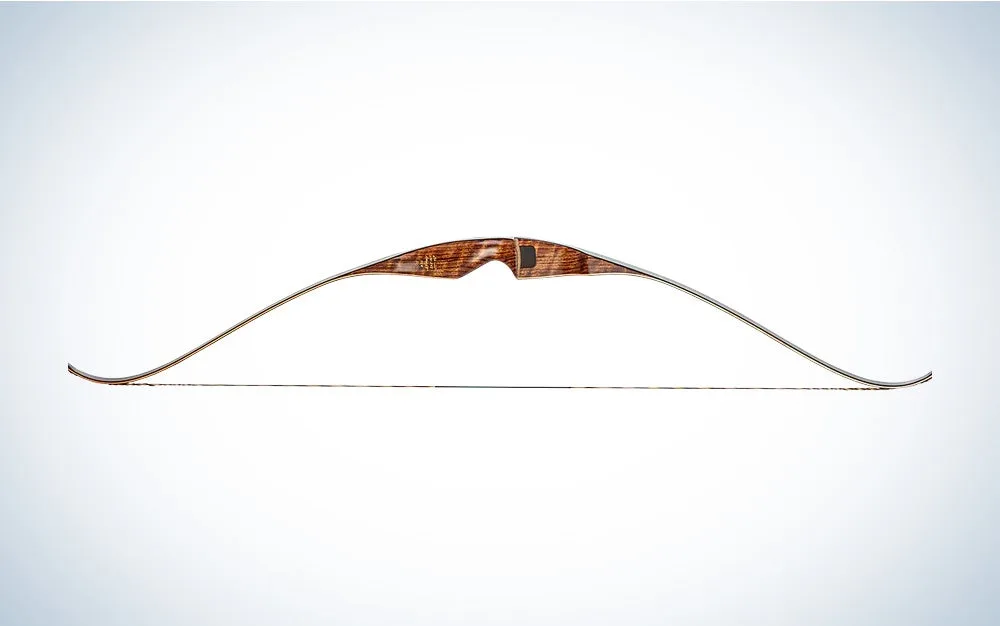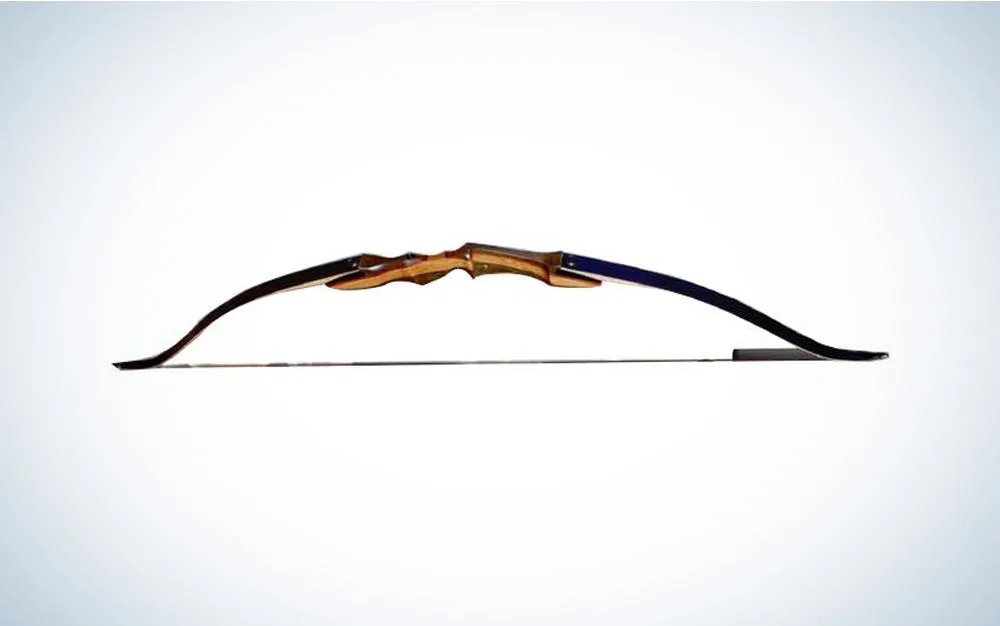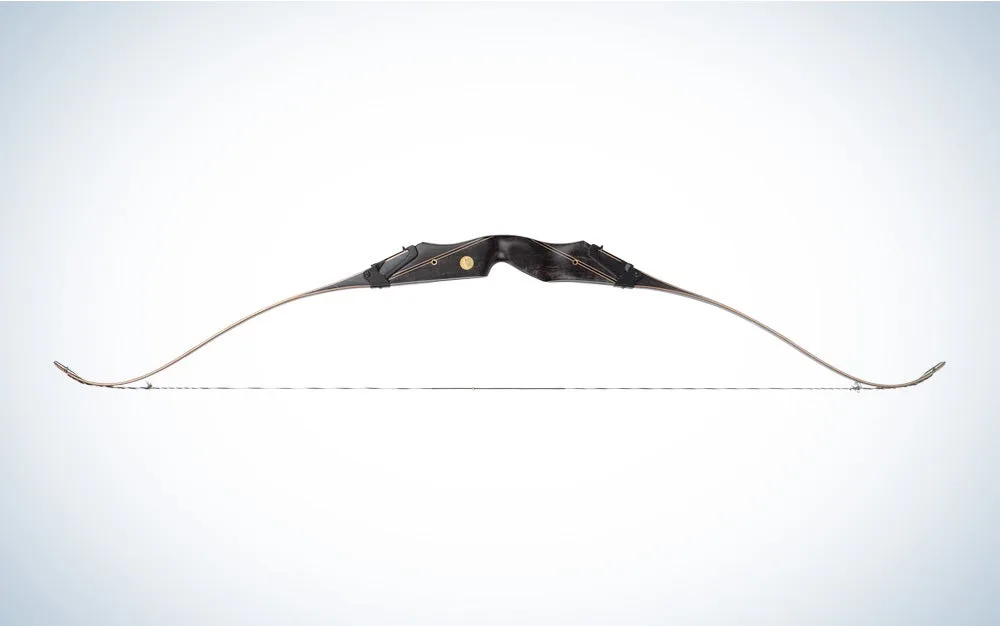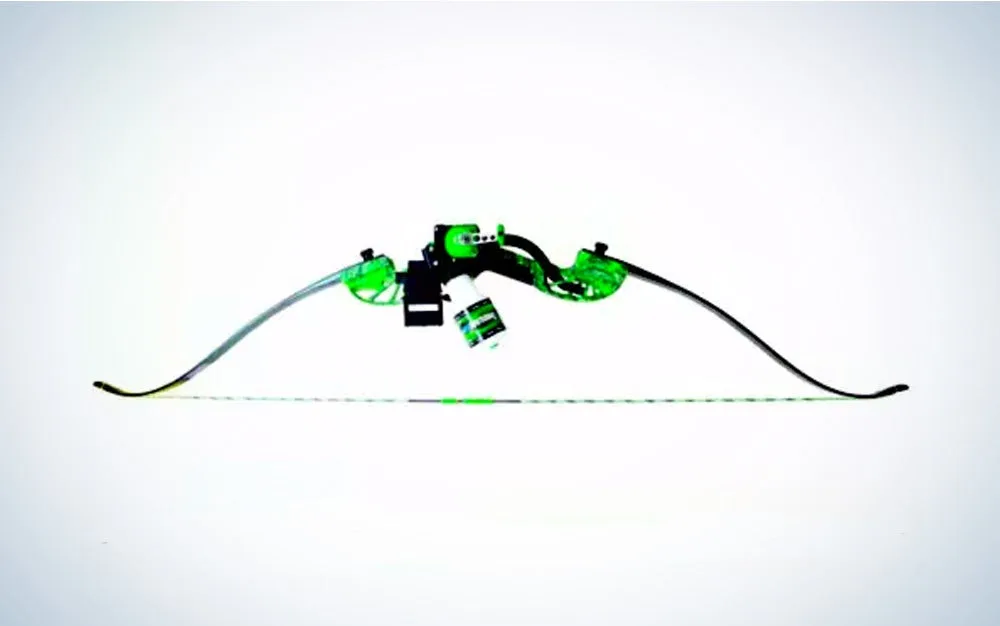We may earn revenue from the products available on this page and participate in affiliate programs. Learn more ›
When it comes to traditional archery, recurve bows are hard to beat. In an era where compound bows are continually advancing, recurves keep things simple. These bows provide a challenge for hunters and target archers who have mastered the compound and are looking for something new. But don’t let the simplified nature fool you. Traditional bows are quite capable of harvesting everything from whitetails to grizzly bears.
The good news is that it’s easier to get into traditional archery than ever before. Quality recurve bows are also rather affordable when compared to compounds or crossbows. It is also a great entry point for the prospective archer wanting to learn how to shoot a bow. With that in mind, here are the best recurve bows for hunting and target shooting.
Best Overall: Bear Archery Grizzly
Best for Beginners: Western Archery The Edge
Best Takedown: Hoyt Satori
Best for Deer Hunting: Bear Archery Fred Bear Takedown
Best Budget: Samick Sage
Best For Target Shooting: PSE Pro Max
Best for Bowfishing: AMS Bowfishing Water Moc
How We Picked the Best Recurve Bows
We looked at simple but important criteria when determining the best recurve bows. Unfortunately, with traditional archery, there is no one-size-fits-all approach. What works great for one archer is another’s nightmare. Therefore, we mainly considered the materials and construction of the bows. Each archer is going to have a different feel that makes “best” rather subjective in this case. However, here are some important considerations we made before adding a bow to this list:
Limbs: What material are the limbs made from? Are these cheaper proprietary limbs? Or are they high-grade ILF-style limbs?
Value: How does the cost compare to the quality of the build? Is this a bare-bones riser and limbs? Or does this bow include everything you need in a complete kit?
Brand Rep: Some brands have a reputation for making quality bows. Does this bow live up to the standards set?
Portability: Is this bow one piece? Or is it a takedown model that easily transports and stores when not in use?
Best Recurve Bows: Reviews and Recommendations
Best Overall: Bear Archery Grizzly

Key Features
Material: Maple and fiberglass
Draw Weights: 30 – 60 Pounds
Draw Length: 28 inches
Pros
Timeless, proven design
Beautiful aesthetics
Surprising affordability
Cons
A little unforgiving for newbies
It’s hard to go wrong with a design proven by the late, great Fred Bear. The Grizzly was first introduced in 1950 and has been harvesting big game animals ever since. This beautiful bow uses a classic wooden limb design with a fiberglass backing. It’s this construction technique that originally helped put the company on the map and the reason this bow shoots incredibly fast. Because it’s an older design, the bow is a little unforgiving for new archers. However, given the range of draw weights and the bargain price, under $500, the Grizzly is still one of the best traditional bows out there. We also love the beautiful aesthetics of this one.
Best for Beginners: Western Archery The Edge

Key Features
Material: Dymond Wood, White Oak, Hard Maple
Draw Weights: 25 – 55 Pounds
Draw Length: 28 inches
Pros
Great price point
Simple design
Low starting draw weights
Cons
Arrow rest isn’t great
It’s always hard to recommend a beginner bow because each archer’s starting point is different. However, we like the Western Edge for newbies due to the low price point and a bevy of features. Western Edge also offers a complete kit that includes a stringer, a case, an arrow rest, a nock set, a tab, and an armguard—everything you need to start shooting. We’d recommend starting off at the 25 or 29-pound draw weights to get used to shooting and build your way up from there. Consider replacing the arrow rest and string after purchase, as they both are weak points of the bow.
Best Takedown: Hoyt Satori

Key Features
Material: Machined aluminum
Lengths (Riser): 17”, 19”, 21”
Overall Lengths: 58” – 66”
Weight: 2.3 – 2.5 Pounds
Pros
Incredibly versatile
Lightweight
Strong and accurate
Cons
Expensive
When Earl Hoyt Jr. designed the international limb fitting system back in the 80s, it was so revolutionary that it became an industry standard. Today the Satori is one of the best takedown recurves. This bow is sold as either just the riser or as a complete package with maple limbs. However, more serious archers will probably want to upgrade those limbs to the bamboo carbon Velos limbs. The Velos limbs just perform much better in nearly every aspect of the bow’s operation, especially vibration.
Hoyt includes some adjustability in the shelf module plates that allow adjustments to the center shot. Flemish twist strings are also standard. Hoyt gives a little extra value with a carrying case too. It’s an expensive bow, but one with a sterling reputation that has become the gold standard for modern ILF recurve bows.
Best for Deer Hunting: Bear Archery Fred Bear Takedown

Key Features
Material: Fiberglass and Maple
Limb Weights: 30 – 70 Pounds
Draw Length: 28 inches
Pros
Extremely portable
Excellent craftsmanship
Great grip
Cons
Price
Another timeless design by Fred Bear, this riser is completely customizable to each deer hunter’s individual needs. Bear Archery builds two different risers that create different-sized bows depending on the limbs they are paired with. The “A” risers create an overall bow length of 56-60 inches, while the B risers make 60-64-inch bows. The wide range of draw weights also means there’s a setup for each hunter’s preferences. The grip on this bow is wide and ergonomic and helps eliminate excess vibration. While we like it best for deer, it also transitions rather seamlessly to other forms of big game hunting simply by adding heavier limbs.
Best Budget: Samick Sage

Key Features
Material: Fiberglass, Maple, Metal
Length: 62 inches
Draw Length: 28 inches
Draw Weights: 25 – 60 Pounds
Pros
Affordable
Limbs are easy to change
Set up for accessories
Cons
String could be better
We know the adage “you get what you pay for” usually rings true. However, the Sage is one of those rare exceptions. This is the best bow for under $200. It’s a good choice for beginners because the limbs can quickly be switched out to change the speed and handling once you gain confidence. Start with a lower draw weight and work your way up from there. With this bow, there are reports of twisted limbs from the factory, but customer service is usually good at handling issues. Upgrading the stock string is not a bad idea either. Fortunately, this bow is already set up for accessories like an arrow rest or a sight.
This is a solid choice for beginners, and it has nice looks thanks to the maple wood construction. Additionally, the grip should have a familiar feeling for experienced compound enthusiasts. The limbs are proprietary and not ILF standard. Thus, some users might quickly outgrow it. However, for the price point, this bow is a great starting point for traditional archery.
Best for Target Shooting: PSE Pro Max

Key Features
Material: Maple and Fiberglass
Draw Weights: 20 and 25 Pounds
Bow Lengths: 54 inches and 62 inches
Pros
Lighter draw weights perfect for target shooting
Affordable
Great for younger shooters
Cons
Limbs can’t be upgraded
Just two lengths
For archers who are only looking to do some target shooting, the PSE is a solid choice. The 20- and 25-pound draw weights are too light for hunting, but they’ll be perfect for target practice. Especially for older kids and teens who don’t want to shoot a kid’s bow anymore. PSE sells this bow in a complete package with three carbon arrows, a hip quiver, an adjustable sight, a stringer, an armguard, and finger savers. The sight is serviceable, but most archers will want to upgrade the rest and arrows as soon as possible.
In truth, the accessories don’t matter so much because the value here is in the bow itself. It’s a bargain at $140. The Pro Max is a maple and fiberglass construction that not only performs nicely, but also looks great too.
Best for Bowfishing: AMS Bowfishing Water Moc

Key Features
Material: Laminated wood, Magnesium riser
Draw Weights: 40, 45, and 50 Pounds
Bow Length: 58 inches
Pros
Ready-to-go bowfishing kit
Good bowstring
Tip wrench is extremely handy
Cons
Case use is specific to fishing only
Why include only one arrow?
Bowfishing is an excellent way to build instinctive shooting skills, and the Water Mox is up for the task. This complete bowfishing kit includes everything to get started, including the AMS Retriever TNT reel. It’s pre-loaded with 350-pound line, so it’s ready for everything from Asian carp to gar. The bow is a takedown model, which makes it extremely portable too. AMS loaded this kit with lots of bowfishing-specific features like a tip wrench built into the riser. This wrench will help swap out bent tips faster so you can get back to fishing.
The Pro Mox is a case-specific bow, which means it won’t get a lot of use off the water. However, anglers will be hard-pressed to find a more complete kit on the market. Additionally, we just like the ruggedness of the construction. Especially the magnesium riser, which can get wet without the worry of damage. It also comes with a quality Flemish bowstring.
What to Consider When Buying a Recurve Bow
It’s not really fair to compare the performance of recurve and compound bows. Recurves usually lack some modern comfort and handling features that are found on compounds. It also tends to make these bows a little harder to silence. Compound bows feature a riser section, synthetic limbs, and cams. The cams turn as you draw the bow, and this turning creates a “let-off” that reduces the weight at full draw. Here are some other key differences.
Draw Weight
Draw weight is important because the heavier the draw, the harder it is to aim. It’s not ideal to be straining to hold at full draw in a hunting scenario. Especially if you’re sitting there waiting for a big buck to clear an obstructing tree. Most traditional hunters will stick in the 45 to 50-pound range when hunting with a recurve. We highly recommend at least 45 pounds for deer hunting.
Additionally, check your state’s regulations before settling on a draw weight for hunting. Because many state wildlife agencies do specify a minimum draw weight for big game.
Draw Length
Shooting an improperly sized bow can affect accuracy. For anyone brand-new to archery, it is best to go to a pro shop to be sized correctly. A pro shop will usually determine draw length by having the shooter draw back with a specially marked measurement arrow. The experts at the pro shop will also catch and correct any improper form techniques that could result in a wrong measurement.
Although most experts agree a rather foolproof method of determining draw length can be done by anyone at home. Simply have the prospective archer stand with their arms apart and measure the “wingspan” from fingertip to fingertip. Once you have that measurement, simply divide the number by 2.5, and you’ll have your draw length. It’s best to do this measurement with the shooter against the wall. Some experienced archers prefer to do this across the back. It is also important the shooter does not stretch or over-extend their arms because this could result in a wrong measurement.
Bow Length
While modern compounds can come in more compact packages at a variety of draw lengths, recurves require the archer to pay attention to the bow’s length too. Having a bow that is too long or too short can affect speed and accuracy. Almost every archer has a differing school of thought on the perfect bow length for each draw weight. However, most agree that the length should at least double the shooter’s draw length.
Unfortunately, the extra length of the recurve can sometimes be a disadvantage. They are not a great choice for compact hunting blinds or anywhere extra tree limbs might strike the bow’s limbs. This means you may need to do a little extra pruning at your favorite stand location for a longer recurve.
FAQs
Q: Is it bad to leave a recurve bow strung?
Most experienced archers agree that older wooden recurves should be unstrung when not in use. It helps prevent damage to the bow. When it comes to modern fiberglass recurves, there are some conflicting schools of thought. Some archers still prefer to keep their bow unstrung when in storage. Other archers never remove the string. Some of this depends on the conditions you store the bow in too. It’s not a good idea to leave a bow stored in a hot place with the string still on it. Some states also have transport laws that prohibit the string from being on the bow when in a moving car.
Q: Which is faster: a recurve bow or a longbow?
In the debate of recurve vs. longbow, the recurve will almost always come out on top in terms of speed. This is because of the design of recurve’s limbs. The curvature allows them to retain much more energy than a longbow. Additionally, recurves are usually more forgiving due to the design of the grip. While recurves have an edge on longbows in speed and handling, longbows are generally quieter.
Q: How much should I spend on a recurve bow?
The great thing about recurves is that they are usually significantly less than a compound. There are always exceptions to this rule, of course. Especially with the high-grade competition bows like those used in the Olympics. Then there are the hand-carved customs made by master craftsmen and women. Those bows often start around $2,000 and have long waiting lists. However, a beginner can get set up with a bow and all the accessories they’ll need for $300 to $350 in many cases. Although if you plan to get serious about using a recurve, it’s not a bad idea to up the budget to at least $500 for a better riser and limb materials.
Best Recurve Bows: Final Thoughts
Best Overall: Bear Archery Grizzly
Best for Beginners: Western Archery The Edge
Best Takedown: Hoyt Satori
Best for Deer Hunting: Bear Archery Fred Bear Takedown
Best Budget: Samick Sage
Best For Target Shooting: PSE Pro Max
Best for Bowfishing: AMS Bowfishing Water Moc
While there are a ton of great recurve bows out there at very reasonable prices, we keep circling back to the Bear Grizzly as our best overall. Some designs are so good that there’s no need to change them. And the Grizzly is a bow that can easily hang with today’s more modernized recurve designs in terms of speed and performance.
Why Trust Us
For more than 125 years, Field & Stream has been providing readers with honest and authentic coverage of outdoor gear. Our writers and editors eat, sleep, and breathe the outdoors, and that passion comes through in our product reviews. You can count on F&S to keep you up to date on the best new gear. And when we write about a product—whether it’s a bass lure or a backpack—we cover the good and the bad, so you know exactly what to expect before you decide to make a purchase.





